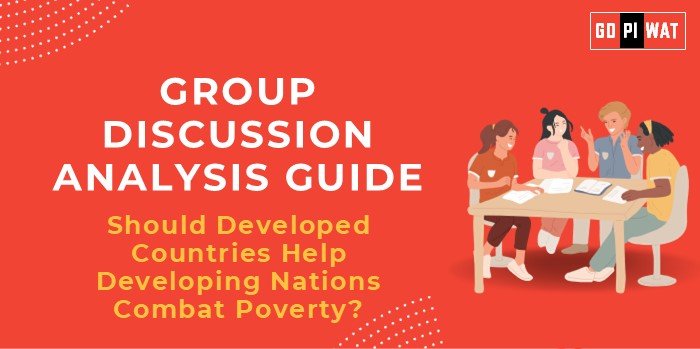📋 GD Analysis Guide: Should Developed Countries Help Developing Nations Combat Poverty?
🌐 Introduction to the Topic
Context: Globally, poverty affects over 700 million people, primarily in developing countries. With wealth concentrated in developed nations, this disparity fuels debates about moral, economic, and political responsibilities. The discussion is especially pertinent for B-school students, given its intersections with global trade, policy-making, and international relations.
Background: This debate traces back to post-World War II reconstruction efforts and the establishment of global institutions like the World Bank and the UN. Over decades, initiatives such as the Millennium Development Goals (MDGs) and Sustainable Development Goals (SDGs) have sought collaborative solutions.
📊 Quick Facts and Key Statistics
- 📉 Global Poverty Rate: 9.2% (2023) – Despite reductions, many nations struggle with extreme poverty.
- 💰 ODA Contributions: $204 billion in 2022 – Developed nations’ Official Development Assistance (ODA).
- 🌍 Developed Nations’ GDP: 60% of global GDP – Indicates resource capacity for support.
- ⚠️ Debt Crisis in Developing Countries: 60% face high debt distress, limiting poverty-alleviation efforts.
🎯 Stakeholders and Their Roles
- 🏛️ Governments of Developed Nations: Provide aid, loans, and policy frameworks for sustainable development.
- 🌏 Developing Countries: Implement strategies for aid utilization and structural reforms.
- 🌐 International Organizations: Facilitate, monitor, and coordinate assistance efforts (e.g., IMF, World Bank).
- 🏢 Private Sector: Drive investments and innovation in underdeveloped regions.
- 🤝 Civil Society and NGOs: Advocate, support grassroots initiatives, and ensure transparency.
🏆 Achievements and Challenges
✨ Achievements:
- 🌟 Eradication Efforts: Countries like Vietnam reduced poverty from 70% (1990) to 6% (2023) via international aid.
- 💚 Global Funds: The Green Climate Fund channels $10 billion annually for developing nations’ resilience.
- 📚 Technology Transfers: Partnerships have improved access to health and education technologies.
⚠️ Challenges:
- 🌀 Dependency Syndrome: Over-reliance on aid limits self-sustainability.
- 📉 Misallocation of Resources: Corruption and inefficiency in recipient countries hinder impact.
- ⚖️ Geopolitical Biases: Aid often serves donors’ strategic interests, diluting its effectiveness.
🌍 Global Comparisons
- 🇸🇪 Success: Scandinavian countries allocate 1%+ of GDP for ODA, fostering impactful projects.
- 🌍 Challenges: Africa’s debt crisis highlights unsustainable borrowing under aid models.
Case Study: Bangladesh leveraged aid for its microfinance revolution, achieving significant poverty reduction.
🗣️ Structured Arguments for Discussion
✔️ Supporting Stance:
“Developed nations have a moral obligation to assist, given their historical contributions to global inequality.”
❌ Opposing Stance:
“Excessive aid fosters dependency, undermining local innovation and self-reliance.”
⚖️ Balanced Perspective:
“Aid should focus on empowering systems rather than perpetuating dependencies.”
🧠 Effective Discussion Approaches
💡 Opening Approaches:
- 📊 Data-Driven Opening: “With $204 billion in global ODA annually, why does poverty persist in developing nations?”
- 📖 Historical Lens: “Post-colonial disparities demand reparative actions from developed nations.”
- 📉 Contrast Approach: “Despite aid flows, developing nations face increasing debt and limited progress.”
🤔 Counter-Argument Handling:
- ✔️ Rebuttal: “Aid leads to dependency.” → “True, but capacity-building initiatives can mitigate this.”
- ✔️ Rebuttal: “Aid is misused.” → “Enhanced monitoring mechanisms like blockchain can ensure transparency.”
🔍 Strategic Analysis of Strengths and Weaknesses
- ✔️ Strengths: Capacity for large-scale aid (e.g., $204B ODA); technological expertise and innovation.
- ❌ Weaknesses: Bias in aid allocation; rising protectionism in developed countries.
- 🌟 Opportunities: Partnerships for SDGs; expanding renewable energy aid projects.
- ⚠️ Threats: Political misuse of aid; economic crises in donor nations reducing funding.
📚 Connecting with B-School Applications
- 🌐 Real-World Applications: Sustainable business strategies in underdeveloped regions; analyzing international financial aid models in macroeconomics.
- ❓ Sample Interview Questions:
- “How can aid models evolve to become more effective?”
- “What role does private investment play in poverty alleviation?”
- 🎓 Insights for B-School Students:
- Understanding global aid dynamics enriches perspectives on sustainable business.
- Aid can inspire projects in social entrepreneurship.


